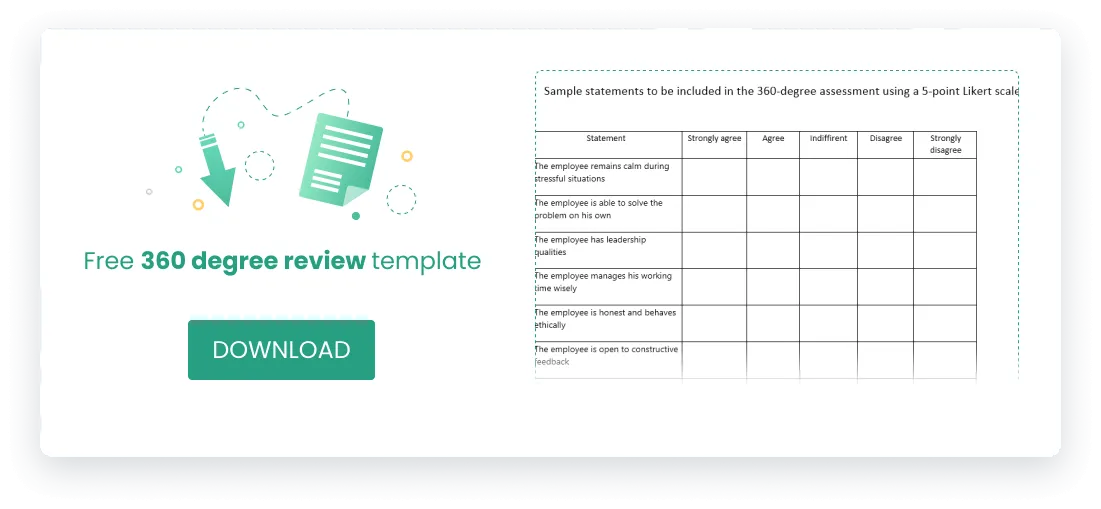360 degree review - template and overview


Periodic employee assessment is necessary to measure the effects of their work, development, and career path in the organization. Discover how to conduct an employee assessment using the 360-degree feedback method and download a free review template from Calamari!
Measuring an employee's progress and planning their future isn't easy, but it's necessary for performance management, employee development, and the proper functioning of the organization. In addition, it allows for detecting problems early and discovering people's potential through constructive and multifaceted feedback.
There are many ways to evaluate employees, depending on the employer's needs. The 360-degree method is multifaceted and one of the basic HR tools. It gathers input not only from managers but also from direct reports, peers, and sometimes even clients – making it a core part of the 360 review process.
Find out what it is, what it consists of, and its advantages and disadvantages – and make the most of a professional 360 feedback template to streamline your 360-degree review process.

What is a 360-degree review
The 360-degree model is an innovative, multifaceted employee assessment technique that allows accurate feedback about employee performance in the organization. Often referred to as 360-degree feedback or a 360 performance review, the method gathers insights from a wide range of sources to paint a complete picture of an employee's strengths and areas for improvement. The model name comes from the 360 degrees of a circle – an association with the employee environment that answers the questions about a given person.
This method allows collecting data about the skills, knowledge, and behavior in the company of the assessed employee. The information is gathered from various sources, including feedback from their peers, managers, and sometimes even clients, making it one of the most holistic tools in the performance review process. Of course, you can collect various types of data depending on the circumstances and the company's needs. The kind of information is also different due to the employee's position.
The 360-degree review may be attended by several to several dozen people. Therefore, the proximity of respondents' contact with the assessed employee should be considered when selecting the participants. To get the most meaningful answers, respondents need to know the employee in question so they can provide helpful information based on real experiences.
As a result of the 360 performance review, there are four categories of obtained information: strengths, development areas, discrepancies, and hidden strengths of the employee. These reports serve as a valuable resource for HR and team leads to understand how employees can improve their performance.
The purpose of the employee 360-degree review is to determine the employee's strengths and the critical areas of their professional development. Using tools like a 360 performance review template or a template for 360 evaluations helps standardize the process and ensures consistent data collection across roles. In the context of the whole organization, this data increases the effectiveness of individuals and entire teams.
To get the most out of the process, it's important to use clear, well-crafted 360 feedback questions tailored to the goals of the evaluation.
Information sources in the 360-degree method
In a 360-degree review, the source of information is the respondents chosen to assess the given employee. All the data that can be collected depends on their answers. You must remember that the responders should be those who came into contact with the assessed person often enough to be reliable sources.
People who can be responders of the assessment:
- immediate superiors,
- team members,
- subordinates,
- HR specialists,
- the assessed employee,
- Employees in equal positions,
- external and internal clients.
Who can use 360-degree review
Despite the possibility of reviewing an employee from a broad perspective provided by the 360-degree assessment model, it's not the solution for every type of organization. In addition, the method requires a high level of security and trust in the company to be genuinely insightful.
Numerous studies conducted by psychologists (Craig, S. Bi Hannum, K, 2006) allowed identifying the features of the organization in which this model functioned properly. Such organizations typically:
- treat change and continuous learning as essential to success,
- ensure an open flow of information,
- have senior management that views open communication as a key factor in organizational success,
encourage senior employees to embrace change for personal growth and the company's development,
and promote regular discussions between managers and employees about business results.
When planning the appraisal, you should inform workers about the chosen methods and familiarize them with the way and purpose of gathering information and how to use it. The anonymity of the responders should be ensured to obtain the most accurate information.

How to conduct a 360 performance review
The 360-degree method is an anonymous survey. It is carried out using a form containing various questions for 360 about the examined person, which allows gathering the necessary information. Many companies use a 360-degree feedback template or a ready-to-use 360 review template to simplify the process and ensure consistency across evaluations.
The test process consists of several stages:
- Selecting the skills to be measured – you should consider which information is the most important in the context of the employee and their functioning in the organization. Focus on a few selected areas to achieve meaningful results through the 360-degree assessment. Unlike traditional performance reviews, this method provides a broader perspective, but it’s still significant not to try to evaluate everything at once.
- Making employees aware – before conducting the 360-degree assessment, explain the purpose clearly. Let employees know why it's essential, how it differs from traditional performance reviews, and how it can help improve the organization's functioning. This step is especially essential when you plan to implement 360 reviews company-wide.
- Ensuring the anonymity of the survey – anonymity significantly impacts the honesty of responses. Subordinates are often reluctant to assess their superiors negatively for fear of repercussions. Therefore, an anonymous survey works best, giving respondents a sense of security and encouraging honest feedback, which is crucial when it comes to 360 feedback.
- Create a 360-degree evaluation form – questions should be based on previously selected focus areas. If you're not sure where to begin, using a ready-made 360 reviews template can get you started quickly and effectively. The form should be easy to complete in 15–20 minutes to maintain consistency and avoid fatigue-related inaccuracies. Start with brief instructions on how to complete the survey.
- Sharing the survey – this can be done via paper or electronic forms. The digital option makes it easier to collect, analyze, and compare responses. It's also more suitable for continuous performance management, as it supports quicker iterations and follow-ups.
360-degree review pros
The 360-degree method comes with many pros. First, it allows you to define the areas that need changes and improve the organization's efficiency within the organization.
Secondly, insightful answers gathered through feedback from multiple sources are a great way to identify problems and develop effective solutions. Using well-crafted 360 review questions helps ensure the feedback is relevant and actionable.
If adequately conducted with complete anonymity, information collected with a 360-degree method from various perspectives makes the results more objective. Moreover, people are more open to sharing their honest opinions when they're not afraid of the consequences. Many companies use 360 feedback tools or a template to gather and organize data efficiently, making the process smoother.
The 360-degree review method helps uncover issues within teams and recognize behavior patterns that positively impact work efficiency. As part of a broader performance management strategy, it supports long-term growth by highlighting areas where individuals genuinely want to do better.
360-degree review cons
Despite its numerous advantages, the 360-degree rating also has its disadvantages. The main one is the time-consuming research and the effort of many people in conducting the assessment. It's also an expensive method that often requires hiring an additional person to complete the process.
There's a risk that the assessed managers won't be optimistic about the assessment. They may even be reluctant because they fear unfair judgment focused on pointing out their mistakes.
Additionally, suppose employees won't understand the reason for the review and how it can help improve the company's workflow. In that case, they may not see a point in conducting the assessment. That's why it's essential to make sure people know the idea standing behind the review.
360 feedback template – summary
The 360-degree review method is a great way to gather a wide range of information that helps define an employee’s strengths, challenges, and path for growth and development. When done well, it can be part of the best 360 feedback practices used to support a comprehensive performance management solution.
By conducting 360 reviews with clarity and structure, and using ready-made templates or carefully selected 360 feedback examples, organizations can streamline the process and make it easier for employees to provide honest, valuable input. Well-designed questions will help gather actionable insights that lead to meaningful improvements.
Still, while the method is powerful, it's not suited for every company. To make 360 feedback effective, the organization must have a culture of trust and openness.
If you are keen to know more about people management and improving company efficiency, take a look at our HR blog. And if you like to know how Calamari can help your business, check Calamari's Performance Review module or contact us now!


















